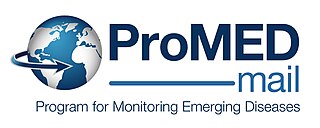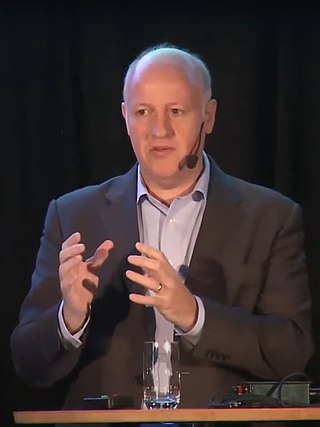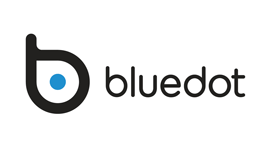Related Research Articles

In epidemiology, an outbreak is a sudden increase in occurrences of a disease when cases are in excess of normal expectancy for the location or season. It may affect a small and localized group or impact upon thousands of people across an entire continent. The number of cases varies according to the disease-causing agent, and the size and type of previous and existing exposure to the agent. Outbreaks include many epidemics, which term is normally only for infectious diseases, as well as diseases with an environmental origin, such as a water or foodborne disease. They may affect a region in a country or a group of countries. Pandemics are near-global disease outbreaks when multiple and various countries around the Earth are soon infected.
EcoHealth Alliance is a US-based non-governmental organization with a stated mission of protecting people, animals, and the environment from emerging infectious diseases. The nonprofit is focused on research that aims to prevent pandemics and promote conservation in hotspot regions worldwide.
The index case or patient zero is the first documented patient in a disease epidemic within a population, or the first documented patient included in an epidemiological study. It can also refer to the first case of a condition or syndrome to be described in the medical literature, whether or not the patient is thought to be the first person affected. An index case can achieve the status of a "classic" case study in the literature, as did Phineas Gage, the first known person to exhibit a definitive personality change as a result of a brain injury.

Program for Monitoring Emerging Diseases is among the largest publicly available emerging diseases and outbreak reporting systems in the world. The purpose of ProMED is to promote communication amongst the international infectious disease community, including scientists, physicians, veterinarians, epidemiologists, public health professionals, and others interested in infectious diseases on a global scale. Founded in 1994, ProMED has pioneered the concept of electronic, Internet-based emerging disease and outbreak detection reporting. In 1999, ProMED became a program of the International Society for Infectious Diseases. As of 2016, ProMED has more than 75,000 subscribers in over 185 countries. With an average of 13 posts per day, ProMED provides users with up-to-date information concerning infectious disease outbreaks on a global scale.
Tele-epidemiology is the application of telecommunications to epidemiological research and application, including space-based and internet-based systems.
The International Society for Disease Surveillance (ISDS) is a 501(c)(3) nonprofit organization, based in Boston, Massachusetts, dedicated to the improvement of public health by advancing the science and practice of disease surveillance. ISDS facilitates interdisciplinary collaboration, promotes and conducts research, education, and advocacy. ISDS's 400+ membership represents professional and academic subject matter experts in the fields of public health surveillance, clinical practice, health informatics, health policy, and other areas related to national and global health surveillance. ISDS holds an annual national conference for the public health surveillance community. The ISDS is a member society of the Global Health Workforce Alliance founded in 2006.

A superspreading event (SSEV) is an event in which an infectious disease is spread much more than usual, while an unusually contagious organism infected with a disease is known as a superspreader. In the context of a human-borne illness, a superspreader is an individual who is more likely to infect others, compared with a typical infected person. Such superspreaders are of particular concern in epidemiology.

A public health emergency of international concern is a formal declaration by the World Health Organization (WHO) of "an extraordinary event which is determined to constitute a public health risk to other States through the international spread of disease and to potentially require a coordinated international response", formulated when a situation arises that is "serious, sudden, unusual, or unexpected", which "carries implications for public health beyond the affected state's national border" and "may require immediate international action". Under the 2005 International Health Regulations (IHR), states have a legal duty to respond promptly to a PHEIC. The declaration is publicized by an IHR Emergency Committee (EC) of international experts, which was developed following the 2002–2004 SARS outbreak.
John Brownstein is a Canadian epidemiologist and Professor of Medicine at the Harvard Medical School as well as the Chief Innovation Officer at Boston Children’s Hospital. His research focuses on development of computational methods in epidemiology for applications to public health also known as computational epidemiology or e-epidemiology He is also the founder of several global public health surveillance systems including HealthMap. He is most known for his work on global tracking of disease outbreaks.
Crowdmapping is a subtype of crowdsourcing by which aggregation of crowd-generated inputs such as captured communications and social media feeds are combined with geographic data to create a digital map that is as up-to-date as possible on events such as wars, humanitarian crises, crime, elections, or natural disasters. Such maps are typically created collaboratively by people coming together over the Internet.

Wildlife trafficking practices have resulted in the emergence of zoonotic diseases. Exotic wildlife trafficking is a multi-billion dollar industry that involves the removal and shipment of mammals, reptiles, amphibians, invertebrates, and fish all over the world. Traded wild animals are used for bushmeat consumption, unconventional exotic pets, animal skin clothing accessories, home trophy decorations, privately owned zoos, and for traditional medicine practices. Dating back centuries, people from Africa, Asia, Latin America, the Middle East, and Europe have used animal bones, horns, or organs for their believed healing effects on the human body. Wild tigers, rhinos, elephants, pangolins, and certain reptile species are acquired through legal and illegal trade operations in order to continue these historic cultural healing practices. Within the last decade nearly 975 different wild animal taxa groups have been legally and illegally exported out of Africa and imported into areas like China, Japan, Indonesia, the United States, Russia, Europe, and South America.
Daniel R. Lucey is an American physician, researcher, senior scholar and adjunct professor of infectious diseases at Georgetown University, and a research associate in anthropology at the Smithsonian National Museum of Natural History, where he has co-organised an exhibition on eight viral outbreaks.
FluTrackers is a website, online forum and early warning system which tracks and gathers information relating to a wide range of infectious diseases, including flu and assists in how to use it to inform the general public. It was co-founded by Sharon Sanders & Jeremy Walsh in 2006, initially to investigate seasonal influenza, novel influenza, and chikungunya. Later, it extended to include Ebola, Zika and drug resistant bacteria. In the first ten months of 2017, it received 18 million views.

The Wuhan Huanan Seafood Wholesale Market, simply known as the Huanan Seafood Market, was a live animal and seafood market in Jianghan District, Wuhan City, the capital of Hubei Province, in Central China.

Michael Joseph Ryan is an Irish epidemiologist and former trauma surgeon, specialising in infectious disease and public health. He is executive director of the World Health Organization's Health Emergencies Programme, leading the team responsible for the international containment and treatment of COVID-19. Ryan has held leadership positions and has worked on various outbreak response teams in the field to eradicate the spread of diseases including bacillary dysentery, cholera, Crimean–Congo hemorrhagic fever, Ebola, Marburg virus disease, measles, meningitis, relapsing fever, Rift Valley fever, SARS, and Shigellosis.
Maimuna (Maia) Majumder is a computational epidemiologist and a faculty member at Harvard Medical School and Boston Children's Hospital's Computational Health Informatics Program (CHIP). She is currently working on modeling the spread of the COVID-19 pandemic.
Alexandra Phelan is a faculty member of the Center for Global Health Science and Security at Georgetown University School of Medicine and an assistant professor in the Department of Microbiology and Immunology at Georgetown University. She specializes in legal and policy issues that are related to emerging and reemerging infectious diseases, as well as health threats posed by climate change.

Peter Daszak is a British zoologist, consultant and public expert on disease ecology, in particular on zoonosis. He is the president of EcoHealth Alliance, a nonprofit non-governmental organization that supports various programs on global health and pandemic prevention. He is also a member of the Center for Infection and Immunity at the Columbia University Mailman School of Public Health. He lives in Suffern, New York.

This article documents the chronology and epidemiology of SARS-CoV-2 in 2019, the virus that causes coronavirus disease 2019 (COVID-19) and is responsible for the COVID-19 pandemic. The first human cases of COVID-19 known to have been identified were in Wuhan, Hubei, China, in December 2019. It marked the beginning of the 2019–2020 COVID-19 outbreak in mainland China.

BlueDot Inc. is a Canadian artificial intelligence software company based in Toronto, Ontario. The company's flagship product is Insights, a software-as-service used to map the spread of infectious diseases.
References
- ↑ Brownstein JS, Freifeld CC, Reis BY, Mandl KD (2008) Surveillance Sans Frontières: Internet-Based Emerging Infectious Disease Intelligence and the HealthMap Project. PLoS Med 5(7): e151. Archived 2008-08-09 at the Wayback Machine
- ↑ Barclay E (2008). Predicting the next pandemic. Lancet.
- ↑ Martin Enserink (2008) Google Grants Fight Disease. Science 322: 517.
- ↑ Freifeld CC, Mandl KD, Reis BY, Brownstein JS (2007) HealthMap: Global infectious disease monitoring through automated classification and visualization of Internet media reports. J Am Med Inform Assoc.
- ↑ Nelson R (2008). HealthMap: the future of infectious diseases surveillance? Lancet Infect Dis 8: 596.
- ↑ Associated Press (9 August 2014). "Online tool nailed Ebola epidemic". www.politico.com. Politico. Retrieved 10 August 2014.
- ↑ "How an algorithm detected the Ebola outbreak a week early, and what it could do next". 26 August 2014. Retrieved 22 November 2014.
- ↑ "Viral Pneumonia Infects Almost 60 in Central China | HealthMap" . Retrieved 2020-04-10.
- ↑ "Coronavirus Researchers Are Using High-Tech Methods to Predict Where the Virus Might Go Next". 11 February 2020. Retrieved 2020-04-10.
- ↑ "Epidemie-Früherkennung: Künstliche Intelligenz allein reicht nicht aus" (in German). 21 February 2020. Retrieved 2020-04-10.
Das automatisierte HealthMap-System am Kinderkrankenhaus von Boston meldete, dass es in der chinesischen Stadt Wuhan Fälle einer unbekannten Lungenentzündung gebe. Das System, das Online-Nachrichten und Berichte auf Social Media scannt, gab dem Vorfall nur die Priorität drei auf einer bis fünf aufsteigenden Skala.